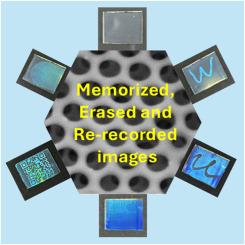用于形状记忆的聚合物光子晶体
IF 8.2
2区 材料科学
Q1 MATERIALS SCIENCE, MULTIDISCIPLINARY
引用次数: 0
摘要
形状记忆聚合物(SMPs)是一种新型的智能材料,能够在各种外部因素的作用下从原始形状改变到临时形状和向后形状。SMPs可以用来形成光子晶体(PCs),显示出可切换的结构颜色。本文将聚乙二醇二丙烯酸酯(PEGDA)和乙氧基乙氧基丙烯酸酯(EOEOEA)单体的混合物聚合在硅蛋白石模板中,制备了一种新的形状记忆光子晶体(SMPCs)。所得的大孔反蛋白石pc是由具有低玻璃化转变温度的橡胶共聚物组成的。利用纳米形状记忆效应实现室温下的光存储器。在这些存储器中,光子停止带被水的毛细凝结所抑制,从而使它们的“冷”编程成为可能。通过蒸发低表面张力的液体,如乙醇、丙酮、环己烷和正己烷,可以使阻带恢复到初始的光谱位置。用弱接触压膜也可达到同样的效果。在冷编程和恢复过程中,PC结构在无序状态和高度有序状态之间切换。同时,样品表现出鲁棒性,在高达1 MPa的显著机械载荷下保持无损。利用发达的记忆,我们成功地记住了复杂的图案。我们预见基于smp的pc将应用于可切换响应传感器、液体打印、可擦除水印、信号谐振器、信息技术和生物医学应用。本文章由计算机程序翻译,如有差异,请以英文原文为准。

Polymer photonic crystals for shape memory applications
Shape memory polymers (SMPs) are novel smart materials capable of changing their shape from original to temporary and backward under the effect of various external factors. SMPs can be used to form photonic crystals (PCs), demonstrating a switchable structural color. Herein, we compose a new shape memory photonic crystal (SMPCs) by polymerizing a mixture of ethoxyethoxyethyl acrylate (EOEOEA) and poly (ethylene glycol) diacrylate (PEGDA) monomers in the silica opal templates. The resulting macroporous inverse opal PCs are composed of a rubbery copolymer with a low glass transition temperature. The nanoscale shape memory (SM) effects in these PCs are employed to realize optical memories operational at room temperature. In these memories, photonic stop bands are suppressed by the capillary condensation of water that enables their ‘cold’ programming. The stopbands can be restored to the initial spectral positions by evaporation of liquids characterized by low surface tension such as ethanol, acetone, cyclohexane and n-hexane. The same effect may be achieved by weak contact pressing on the film. During cold programming and recovery, the PC structures switch between disordered and highly ordered states. At the same time, the samples demonstrated robustness, remaining undamaged under a significant mechanical load of up to ∼1 MPa. We successfully memorized complex patterns with use of the developed memories. We foresee applications of SMP-based PCs in switchable responsive sensors, liquid printing, erasable watermarks, signal resonators, information technology, and biomedical applications.
求助全文
通过发布文献求助,成功后即可免费获取论文全文。
去求助
来源期刊

Materials Today Nano
Multiple-
CiteScore
11.30
自引率
3.90%
发文量
130
审稿时长
31 days
期刊介绍:
Materials Today Nano is a multidisciplinary journal dedicated to nanoscience and nanotechnology. The journal aims to showcase the latest advances in nanoscience and provide a platform for discussing new concepts and applications. With rigorous peer review, rapid decisions, and high visibility, Materials Today Nano offers authors the opportunity to publish comprehensive articles, short communications, and reviews on a wide range of topics in nanoscience. The editors welcome comprehensive articles, short communications and reviews on topics including but not limited to:
Nanoscale synthesis and assembly
Nanoscale characterization
Nanoscale fabrication
Nanoelectronics and molecular electronics
Nanomedicine
Nanomechanics
Nanosensors
Nanophotonics
Nanocomposites
 求助内容:
求助内容: 应助结果提醒方式:
应助结果提醒方式:


